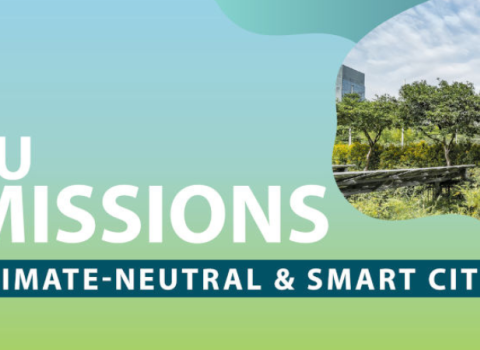Navigating the next steps for EU research Missions – and for EU R&I as a whole - requires a steady hand and building on experience to date

Iacopo Gronchi (left), policy expert at Demos Helsinki and PhD candidate at the University College London Institute for Innovation and Public Purpose, and Steffen Korsgaard (right), professor of Entrepreneurship at the Centre for Business Development and Policy, University of Southern Denmark. Gronchi's photo credits: Demos Helsinki. Korsgaard's photo credits: University of Southern Denmark
Negotiations between the European Commission and member states on Framework Programme 10 are in full swing, at a time when reports from Enrico Letta, Mario Draghi, and Manuel Heitor's expert group have highlighted how the EU’s productivity and economic growth are hanging on a reboot of how the EU invests in innovation.
In this context, policy work that is in progress looking at the implementation of the ongoing EU research Missions is both a starting point for the future of R&I envisioned in the high-level reports, and an under-utilised tool for helping to articulating the new European Commission's strategic vision.
However, making the most of the Missions will require much rethinking, in particular, with a closer eye on implementation challenges and the development of safeguards against Mission ‘mess’, drift, and capture.
While Missions can direct innovation toward the pressing challenges facing the EU, implementation challenges loom large. We believe many of these challenges are a result of a failure to understand the context in which Missions are set up, structured and run, and the associated risks.
The development and implementation of Missions involves a dilemma around transformation and continuity. While the transformative potential of Missions depends on a break from existing practices, their impact depends on the involvement and leveraging of existing structures, administrators and partners.
Missions started within the Horizon programme inherit a range of instruments, organisational routines and structures, and institutional logic related to research and innovation, as well as existing staff who are responsible for implementation. On the one hand this is an enabler, because actions are taken by experienced administrators, drawing on existing competencies and networks.
But on the other hand, this opens the door for ‘business as usual’, constraining the potential for transformation in the longerterm.
This leaves Missions vulnerable to at least three risks we uncovered in our engagements with policy makers, administrators and private sector actors involved in Missions. Overcoming and managing these risks is necessary to successfully develop and implement Missions.
Mission ‘mess’
The first risk is giving Missions too many goals and ambitions. While research indicates some ambiguity in Mission goals can be beneficial, goal structures can easily become overloaded and pull Missions in different directions, undermining their objectives. This may occur if for example, Missions aiming to support the green transition are loaded with additional goals, such job creation or generating exports.
Mission drift
Drift occurs when pressures to secure continued funding, or to meet milestones and key performance indicators (KPIs) lead to drift from the overall Mission goal. A particular threat here is the imposition of traditional performance evaluation templates with linear innovation models, stage gate models and KPIs, on Mission work and evaluation.
This risk of drift is exacerbated when Missions are staffed with administrators, composed of partners, and monitored by politicians who are vested and experienced in older innovation policy regimes where linear models of innovation, for example, technology readiness levels, stage gate models and KPIs, and economic targets are commonplace.
Mission capture
The risk of Mission capture comes when strong partners co-opt a Mission to pursue distinct interests of their own. Missions that involve powerful partners such as large companies or industry groups are particularly susceptible to this challenge. At worst, Missions captured by such interests do not deliver on their potential to contribute to the long-term public interest.
Bottom-up innovation involving partners from multiple sectors incorporated in Missions calls for deep integration of large incumbents such as multinational companies and universities. Yet, the more such incumbents are involved in the governance of Missions, the more vulnerable they become to capture, especially in mature fields such as health, agriculture and energy, where large incumbents exercise considerable power over policy formulation and funding decisions.
What to do about it?
In addressing these risks, the Missions and policy makers must set up structures and guardrails. Three such structural components are necessary, according to our insights from working with Missions.
First, each Mission must be born with a clear foundation and mandate, specifing clear and consistent goal structures. Here, it is absolutely essential to distinguish between Mission goals and potential positive spillover. While new jobs and economic growth may be positive outcomes of a Mission to lower CO2 emissions, writing them into the mandate will create the risk of Mission mess.
At the same time, it is necessary to make sure that goals from previous policy regimes, typically horizontal and vertical innovation policies, are weeded out at the very early stages.
Next, to avoid drift, Missions need assessment and evaluation frameworks that focus on strategic learning and long term impact, rather than outcome or output measures and KPIs. Missions are dynamic and experimental instruments pursuing higher level goals, and the assessment and evaluation frameworks must reflect this
Third, as many others have pointed out, strong public sector capacity must be built to secure competent governance of Missions and long-term learning. Specifically, Mission governance structures must have sufficient administrative, academic and political capacity to withstand pressures from powerful partners and avoid Mission capture.
Regardless of the EU Missions' future within or beyond FP10, we propose that the new Commission should seize this window of opportunity, to take stock of the first years of the Missions, and set a strong pathway forward. This means not stepping back from the challenges and pitfalls that have been identified, but acknowledging them, and applying this understanding and experience to continuously improve governance.
Iacopo Gronchi is a policy expert at Demos Helsinki and PhD candidate at the University College London Institute for Innovation and Public Purpose, which is directed by Mariana Mazzucato, the economist who advised the Commission to devise “moonshot” challenges in Horizon Europe. This viewpoint reflects only Gronchi’s personal views.
Steffen Korsgaard is a Professor of Entrepreneurship at the Centre for Business Development and Policy, University of Southern Denmark





 A unique international forum for public research organisations and companies to connect their external engagement with strategic interests around their R&D system.
A unique international forum for public research organisations and companies to connect their external engagement with strategic interests around their R&D system.